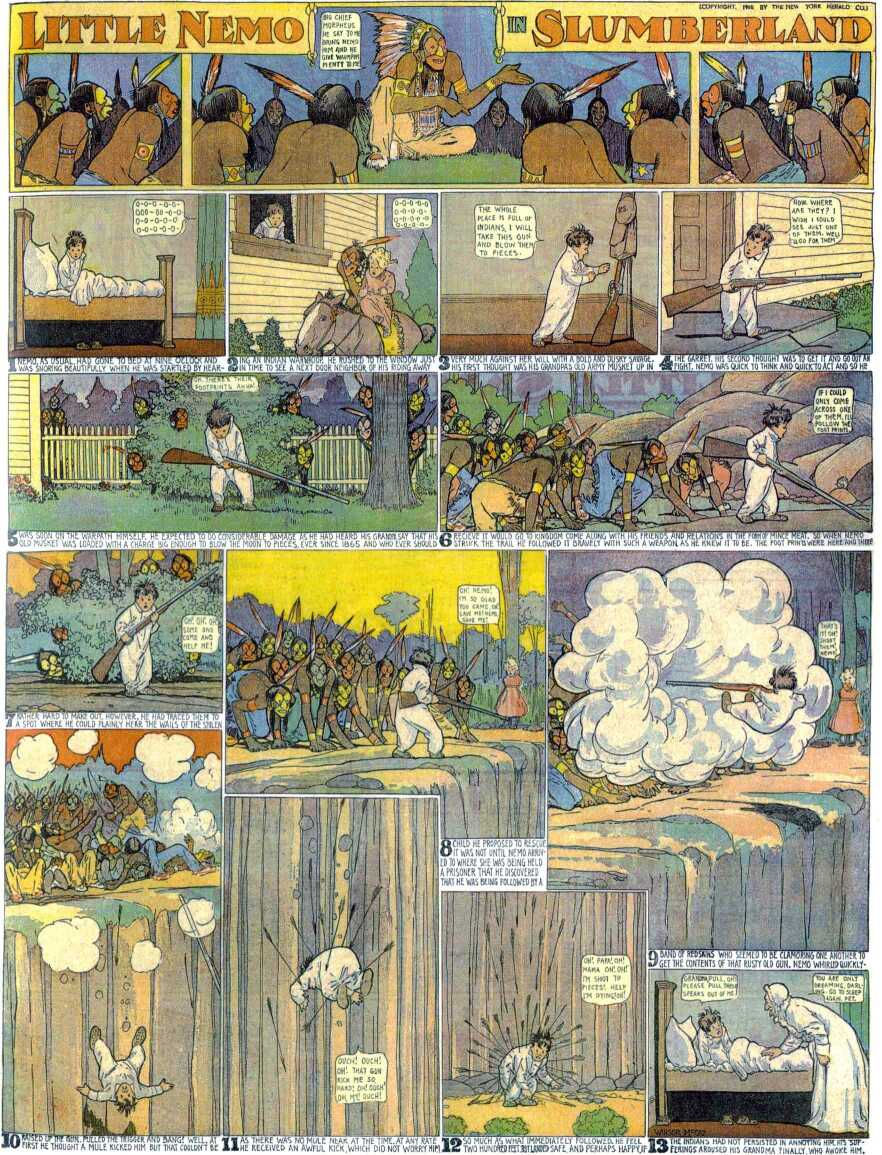Day #13: Little Nemo and the Stolen Child
- Zachary J.A. Rondinelli

- Jun 9, 2020
- 3 min read
"Little Nemo in Slumberland" dated January 07, 1906:

Transcript of Tweets by @LittleNemo1905 (June 9, 2020):
I won't lie… I have not been looking forward to sharing this strip. An egregious examples of early 20th-Century misrepresentation of Indigenous peoples, to say that it is problematic would be an understatement. - 1/22
Here, King Morpheus has enlisted the help of a tribe of Native Americans to assist in bringing Nemo to Slumberland. What follows is nothing short of 16 panels of cultural disparagement. - 2/22
Harkening back to the pioneering comicbook genre of the #Western (which brought with it all of the Native American stereotypes from the dime-store novel that proceeded it), this strip places Nemo as the heroic rescuer of the kidnapped young girl. - 3/22
This was, of course, a very common #Western trope. As Michael Sheyahshe notes in #NativeAmericansInComicBooks, "For the most part, Indigenous people became plot devices to move the story along and make the central character…more heroic" (9). - 4/22 [image of the book]
Furthermore, the strip suggests that McCay's Native Americans represent, to Nemo, what Sheyahshe calls "the racial threat…something alien and hostile to white, and thus civilized culture" (10). - 5/22
Indeed, the kidnapping of the young girl fits both of these conceptions: it places Nemo in a position to be heroic and challenges civilized customs by forcefully removing a young girl from her home. - 6/22
There is an element of (attempted) humour as Nemo trots out of his house with his grandfather gun (bigger than he is) in hopes of being a rescuer, but this potential visual gag is thoroughly undercut by the fact that Nemo's first instinct is to "blow them to pieces." - 7/22
The actions of our young Nemo speaks volumes to the openly racist mindset of the early 20th-century. What's worse is that it demonstrates how even a 5-year old boy can have those deep-seated prejudices. - 8/22
Whether this was true more generally of young people at the time, or was simply McCay's adult sensibilities filtering through our youthful protagonist, I can't say. Unfortunately, I fear that this systemic racism was likely known by children, as well as adults. - 9/22
Obviously, since he used it in a children's comic strip, McCay would have to assume that the young readers would have a basic understanding of "the racial threat" so as to immerse themselves into the narrative (developed through games such as "Cowboys and Indians"?). - 10/22
Some people suggest that "becoming aware of cultural disparagement in comic books has the potential to drain the fun out of reading them" (Sheyahshe, 2). - 11/22
This is not a position that I find tenable today. It's impossible to escape the shameful representations of racial, ethnic, and cultural Others in comics of the past so we must bring our modern sensibilities to bear on the prejudice so as to challenge and not ignore them. - 12/22
"Understanding the contemporary images and perceptions of American Indians in comic books is extremely important, not only for Indian people but also for the mainstream culture" (Pewewardy in Sheyahshe, 2). - 13/22
Beyond critiquing the strip for it's misrepresentation of Indigenous peoples, there isn't much more that this strip offers, in my opinion. - 14/22
Panel 11 (captioned 8) does something interesting by having the panel design mimic the drop-off of the cliff that eventually sets up Nemo's fall when the gun kicks back. - 15/22
I feel as though the design serves only as preparation for the reader to recognize that Nemo has backed himself against a precipice, which prepares the reader for the coming moment when he fires and is sent over the edge. - 16/22
That he falls the 200-ft and lands unharmed (though skewered by many arrows) is somewhat surprising. His descent seems to set-up a falling out of bed gag, but the reader's expectation is thwarted here when Nemo wakes up in his bed with his grandma by his side. - 17/22
Lastly, while this strip is without question one of the most detestable for it's depictions of racial, ethnic, and cultural prejudice, it is a theme that will continue through our reading as we grapple (particularly) with Impie and Flip's representations in future strips. - 18/22
I believe that it is important not to let these characterizations go unchecked as they can help to reveal "ingrained societal and cultural attitudes" (Sheyahshe, 3) that help us better understand both our past and our present. - 19/22
Sheyahshe believes that "comic books can reveal more about popular society and culture than just the black-and-white idea of good versus evil…A comic book can inspire and teach" (3). - 20/22
Hopefully, these caricatures (as well as the others we will encounter) prove themselves antithetical to our worldview today, allowing us a moment reflect on how our society has, and continues to, evolve. - 21/22
This is my reading of "Little Nemo in Slumberland" #13. What's yours? - 22/22





Comments